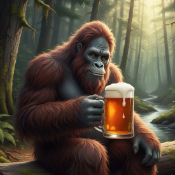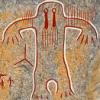Hello hiflier--
I was able to attend the conference, and heard Dr. Disotell's talk. I did a post about the first day of the conference on my Strange Maine blog, and will hopefully get the 2nd day typed up and posted this weekend. Basically, what he had to say was tremendously exciting. I'll cut and paste that part of the post and tweak it a little for all you guys here (and add a few details that I know you'll be interested in too):
His talk focused on the potential for researchers to utilize the recent advances in DNA technology to accomplish species surveys. Using environmental DNA drawn from topsoil, local bodies of water, etc, labs can now determine what species are in a given area, and how long ago they were there in the case of past or transient populations.
Of course we leave traces of our DNA everywhere we go, and so does every other species on earth. This new methodology, environmental DNA metabarcoding, is transforming how we survey animal and plant communities. With this and other tools, Disotell urges us: "Those of us in the cryptozoology field need to do way better than we have done up to now." Up until now, he states, he has seen "zero data to convince [him] of the existence of legendary cryptids," but he is hopeful that access to new DNA technology will advance efforts, especially as the cost has plummeted now. (in answer to your question, hiflier, it sounds like either they haven't crunched the samples you refer to yet, or the data turned out not to be anything indicating an unknown hominid. He was aware of why people were asking about his results up to now.)
In other words -- work hard, learn well, and use new tools -- and always keep in mind that DNA is the keystone of species identification.
The process involves utilizing either local water samples or local dirt samples, and filtering them to separate all the trace DNA types present or having passed through a given area. In the case of dirt or physical debris from the topsoil, etc, the material is pulverized for analysis. He mentioned that rather than doing footprint casts, it would be more useful to cull the topsoil from the area of the print and submit that for testing, as it would undoubtedly contain trace DNA from whatever had left the print.
He said that he is willing to do analysis for people, but "don't just mail me material." Initiating contact with him (his lab) to find out parameters and costs in advance would be the way to go. He said that the process costs a couple grand, but out of that you get hundreds of results, whereas the old systems cost even more and then only gave you results for a single physical specimen sample. You get a full picture of all wildlife, etc, that traverses or inhabits that region now and in the past (depending on how deep the sample digs).
I hope that's helpful! I had a chance to give my own talk about what I've learned about Bigfoot in Maine from the eyewitnesses I've spoken to for the first time, which was an interesting exercise in summarizing a diverse quantity of reports in a wide range of eras into a digestible whole.
Cheers from Portland,
Michelle Souliere



